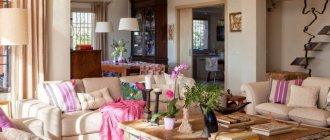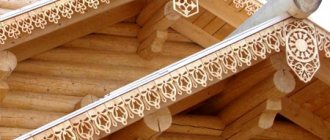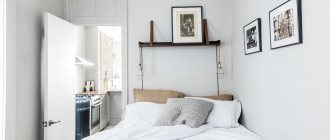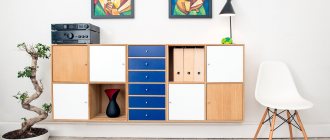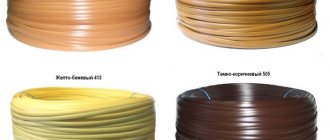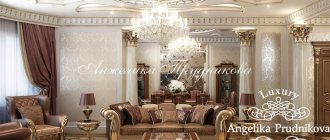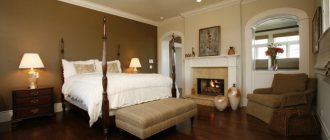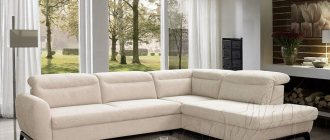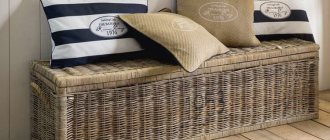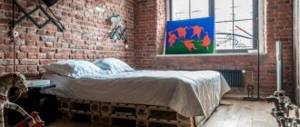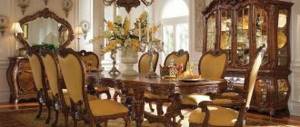Stabilized moss: what is it, where and how is it used, and how to make it yourself
Categories: Articles
In most cases, you don’t have to look far for home decor ideas - often nature itself suggests them and decorators can only draw inspiration from it. One of the latest nature-inspired finishing materials is stabilized moss, which will be discussed in this article. Together we will deal with the question of what this stabilized moss is, where and how is it used and how to work with it?
Stabilized moss: what is it?
To put it in simple and understandable language, stabilized moss is moss in which all biological processes have been preserved. Think of it as cryogenic freezing, if you will. In a way, you can say so, since during the stabilization process all the liquid is drawn out of the plant, and instead of it a special solution is pumped in, which seems to keep the plant alive, but at the same time stops all biological processes in them. In the process of such modification, plants even change their properties and qualities. In particular, natural moss acquires the following qualities that are unusual for it.
- Elasticity and brightness of color that do not fade over several years.
- Unlike living moss, its stabilized counterpart does not require any care at all.
- It is absolutely harmless to people and animals and even has hypoallergenic qualities. This is a natural, environmentally friendly material.
- Moreover, in the process of modernizing moss, it is possible to change its color, which provides many opportunities for decorating rooms.
Along with the positive aspects, the process of moss stabilization also introduces some negative qualities into this material. In particular, stabilized moss cannot be watered; it is afraid of frost and direct exposure to sunlight - in a bright room with natural light its service life is almost halved. Well, in all other respects, this is a material that is quite attractive in appearance and pleasant to the touch, which is designed to please the human eye for a long time.
Use of stabilized plants
Flowers, branches, grass and leaves
Stabilized flowers and other decorative plants (twigs, leaves, herbs) are widely used in creating bouquets and various types of floral arrangements (panels, paintings, wreaths, sculptures, etc.). Products made from preserved flowers will fill any room with natural freshness and the fragrance of natural aromas.
Fragment of wedding decoration made of preserved flowers
Wedding floristry was not without stubs. A bride's bouquet, decoration of her hair, a cortege, a festive table - such decor, unlike freshly cut flowers, will not lose its original appearance either in the scorching heat or in the bitter cold.
No matter how beautiful the fresh buds are, a bouquet of them will last only a few days. No matter how you care for the plants in flowerpots, if you just get distracted a little or go on vacation, they can get sick or dry out. And the flowering period of living indoor flora is usually short. A composition of stubs, created to your taste and in accordance with the interior of the room, will delight the owners and guests for several years.
I really love indoor flowers, but due to frequent long-term business trips, I didn’t risk getting them. Having learned from a friend about such know-how as stabilized plants, I decided to buy a beautiful composition. Fortunately, modern stores offer a wide range of them. I selected successful options for both the bedroom (delicate lilies in an intricately shaped bottle) and the living room (a large bouquet of lilac-violet peonies). The flowers look like they were picked yesterday. And on the kitchen wall she placed a flowerpot with a pot from which green, varnished leaves of preserved ivy hang.
Elena Logvinova, Astrakhan (October 2020)
My mom loves making flowers. That’s why we have as many as 60 rose bushes in our yard alone, and all the window sills are filled with flowerpots. When she goes to some kind of celebration, everyone knows that Aunt Valya will definitely give her either a gorgeous bouquet or a flowering plant in a pot (depending on the season). When her 60th birthday was approaching, we didn't know how to surprise her. But then they decided to present her with a bouquet of huge preserved roses in the middle of winter. Mom accepted the flowers with joy, and when I warned her not to put them in the water, she was very surprised. I had to tell her the secret of the eternal freshness of plants. By June, when her roses began to bloom, my mother had time to study all the nuances of plant conservation, and now we have a house full of gorgeous buds, “born” in June, July, August, and September. The freshest are the chrysanthemums that she cut at the end of October. Now, regardless of the season, when going to a celebration, mom carries exclusively bouquets of stabilized flowers as an addition to the gift. She is delighted that she has learned to “stop time,” that is, to make the natural beauty of plants unfading.
Sergey Shevchenko, Volzhsk (November 2020)
Trees
It is appropriate to use stabilized trees in the interior of spacious houses and apartments, office premises, hotels, and restaurants. These are either real exotic trees (palm, lime, lemon, salal, etc.), or products created from natural branches and leaves. However, the crown of small trees can even be made from moss.
Having opened a hairdresser, I set myself the goal of making my establishment stylish and cozy, but so that the whole environment does not require a lot of time for personal care. Therefore, I chose stabilized bonsai trees as the floral decor for the hall, and for the coffee table I ordered a large colorful bouquet of flowers and herbs. The first thing that impresses my clients is that in the hairdressing salon there is not a specific smell of reagents, but a real mix of natural aromas! And, of course, the hall became very cozy and beautiful.
Maria Bartova, St. Petersburg (July 2020)
Mosses
Scandinavian moss is mainly used for stabilization. It has found wide application in both horizontal and vertical decorative landscaping.
Stabilized moss Yagel red color
Many people are mistaken in thinking that the first involves creating floor carpets. Mosses cannot bear heavy loads. Therefore, horizontal gardening is mainly the decoration of living corners, terrariums and various plant compositions.
More widely preserved mosses are used in vertical gardening:
- For creating wall panels. Logos and paintings made from stabilized moss are an essential component of newfangled eco-design. This material is painted in any shade selected from a wide range, placed in a special frame and becomes a magnificent backdrop for unique compositions of preserved flowers, leaves, and branches.
- To create phytowalls. In this case, moss panels are mounted over the entire wall area. The advantages of this decor are obvious: attractive appearance, excellent soundproofing qualities, soft-touch structure.
- For creating decorative inserts. Their size and shape can be very different: vertical and horizontal, protruding and recessed into the wall, framed or without, narrow and wide, square, round, rectangular, etc. These days, exclusive furniture with decorative inserts is quite in demand.
When choosing stabilized moss to decorate your home, you should pay attention to what method was used to preserve it:
- Glycerin
. The service life of such mosses is 3-7 years. They are softer to the touch, easier to paint (you get bright, saturated shades), but the paint can stain your palms when touched. Such products tend to ignite quickly, so they should not be used for decorating large areas. - Mineral salt
. Service life – from 12 years. There are confirmed cases where wall panels have served for almost half a century without losing their consumer characteristics. Compared to glycerin, mineral salt moss is harder to the touch, and when dyed, it produces calmer, muted shades. Such panels, when in contact with fire, will not burn, but will smolder, which is why they should be given preference when it is necessary to create voluminous interior works.
Our office has a small gym with only equipment and blinds on the windows. The employees were always bothered by the fact that this room was somehow uncomfortable. When one of us studied there, we could hear it in the neighboring rooms. We decided to buy heavy blackout curtains, but they did not save us from problems with sound insulation. All issues were resolved by using stabilized moss in the interior of our “rocking chair”. It has become much more comfortable, there is no echo, and it’s just nice to exercise “in the lap of nature”!
Andrey Vorontsov, Chelyabinsk (May 2020)
How to use stabilized moss in the interior
By and large, the scope of application of stabilized moss is not so large and in most cases comes down to decorating premises - this is horizontal and vertical gardening. Don’t get me wrong, but the floor in its pure form is not covered with this material - you can walk on it, but not for long, since it is not adapted to such loads. In horizontal gardening, it is used as decor for some interior elements - for example, it is used to decorate living corners.
If we talk about vertical gardening, then its scope of application is much wider - on walls this material is less susceptible to force influences and lasts a very long time. In particular, the following decorative elements are created using stabilized moss.
- Phytowalls made of stabilized moss. This is the most common way to use this finishing material - simply put, the entire wall is covered with moss. In principle, there are two technologies for solving the question of how to make stabilized moss on the walls - we’ll talk about this a little later.
- Panel. A beautiful green painting placed in a frame - in most cases, stabilized moss in this decor is used as a background. The decoration itself is provided by other plants that, like moss, have undergone a stabilization process.
- Decorative inserts. Everything here is the same as in the case of many other unique finishing materials - inserts can have different sizes and shapes, they can be recessed or stand out against the background of the wall.
A wall made of stabilized moss is by no means the only solution for using this type of material - it is often used to landscape other interior items. For example, a floor lamp shade, a doorway - in general, anything, as long as it is not subject to physical impact. By and large, if you think through everything carefully, you can even decorate interior door panels with stabilized moss.
Application in the interior
There are no special restrictions on the use of stabilized greens. It is ideal for decorating walls, highlighting individual parts of rooms or zoning them. Typically used to create a comfortable and cozy atmosphere. Can be used to style some types of furniture. Modern craftsmen produce a lot of ready-made jewelry with spore plants: paintings, inscriptions, compositions. For stylization, large panels are also used, which are a long canvas decorated with greenery. The panels are suitable for fixing to walls using self-tapping screws and liquid nails. They do not require additional use of moisture-proofing materials. After installing such panels, the surface behind them remains completely dry. Also, some craftsmen use voluminous plants for direct fixation to walls, shelves, and floors.
Vertical gardening methods
It is quite simple to create unusual wall decorations with spore plants by combining panels of different shades. They can be laid out in patterns or glued to surfaces in strips. The most popular options for decorating rooms with green inserts include:
- complete wall decoration;
Panels with plants are attached close to each other, creating a seamless canvas.
- location between columns;
The optimal solution for elongated rooms. They can be separated by columns or their imitations. Green decorations between the dividers will look sophisticated.
- strip installation;
Vertical narrow panels with spore plants will help raise the ceiling or zoning the room.
- installation of panels (they can be replaced with inscriptions from plants in plastic frames).
Small panels of greenery of different colors, located in the center of the wall or in different parts of it, allow you to add dynamics to the style.
In the kitchen
Styling your kitchen with unusual greenery can be done in different ways. For example, use original materials to create paintings. They will ideally complement the recreation area and make it more comfortable. The stylization of the apron will look great: it can be half or a third made of voluminous greenery. True, it should be located at the top. Direct exposure of artificial lighting to the green part of the apron will make it as attractive as possible. In addition, waste from the work area with this arrangement will not end up on the display. An original solution would be to use panels with moss to zone the work area and the eating area. To do this, the dividing strips should be fixed to the walls and ceiling. A pair of panels framing the kitchen unit around the edges will also look stylish.
The elements need to be fixed on a plasterboard ceiling or a strong partition between two parts of the tension fabrics. Also, fastening the panels from above is allowed for a regular whitewashed ceiling.
In the living room
Spacious rooms are ideal for styling with spore-bearing plants. Having many options for decorating them makes it easy to choose the right ones. The most popular stylistic solutions for landscaping rooms include:
- decorating the wall opposite the sofa (around the TV, mini-wall);
- decorating the wall behind the sofa (to highlight the seating area in an original way);
- decoration of the side walls (relative to the sofa to expand the seating area);
- installation of stylized green partitions (to divide the space of the room);
- installation of small panels in a checkerboard pattern on 2-4 walls.
Installing stylized inscriptions will also help to highlight the room in an original way. They are frames with sides, between which plants are located. Such elements look original and make it easy to update and refresh any design.
In the bedroom
In the bedroom, green panels framed with plasterboard protrusions at the top and bottom will look original. Illumination in them will visually increase the depth of the created niches and make the space free. A profitable solution would be to install panels above the work area (desk or computer desk). They will help create special comfort. Placing spore plants opposite the bed will provide a cozy rest. They can frame the TV or be mounted sporadically over the entire surface of the wall. The green frame of the headboard also looks unusual. It can be a thin frame or occupy all the free space behind the furniture. A couple of paintings or family photos will fit well into this wall design. You can also beautifully highlight the passage to the balcony and window openings with moss.
In the bathroom
Decorating the bathroom with voluminous greenery should be done with special attention. Stabilized plants should be located as far away from the shower area as possible. Otherwise, water getting on the green panel will cause it to quickly deteriorate. It is better to place such a decoration on the wall opposite the shower. Care should be taken to ensure that water from the washbasin does not fall on the surface of the moss. A green frame around the mirror will look very beautiful. With its help, you can emphasize the originality of the design of shelves, installed furniture for storing towels, and cosmetics.
Installing a powerful hood that will work when using the room will help eliminate problems with high humidity. If such measures are not suitable, then it is better to replace stabilized greens with plastic or polymer analogues.
Stabilized moss: methods of vertical gardening
As mentioned above, vertical gardening of walls using stabilized moss can be done in two ways - it can simply be glued to the walls, or it can be made from a moss panel. Both options have their advantages and disadvantages, so you should familiarize yourself with them in more detail.
- Panels made of stabilized moss. This finishing option is good because it causes minimal damage to the walls - the panels are attached to the walls with self-tapping screws, and after their removal a small number of holes remain in the wall. If desired, they can be simply sealed with putty - and the wall is ready for further use. In the sense that it will not need to be further re-prepared, for example, for wallpapering. Making panels yourself is quite simple - they will require moisture-resistant plywood, PVA glue and, of course, stabilized moss, which first needs to be cleared of soil residues. Then you simply glue the moss onto the plywood, covering both it and the plywood with PVA glue - in some ways, this whole process can be compared to putting together a puzzle. The moss pieces fit tightly together. After drying, the panels are simply installed on the wall using dowels, and the holes, or rather the fastening caps, are sealed with the same moss.
- Pasting walls with stabilized moss. The main difference between one and the other method of decorating walls is not only that the glue can hopelessly ruin the surface, which will have to be redone in preparation for another finishing material. Differences are also observed in the method of installing moss on the wall. Firstly, a slightly different glue is used here - PVA will not work here, since each piece of moss will have to be held for a long time until the glue dries. The ideal option is hot-melt adhesive, apply it pointwise, glue it and be done with it. Secondly, this option for decorating walls allows you to carry out work without preparing the base at all - you opened the walls with a primer and you can glue them. A general green background will perfectly hide all surface imperfections - in principle, panels can do this job just as easily.
As you can see, the work is not difficult, and there are practically no nuances here. Except for one thing - if you really want to make beautiful green walls, then you need to have a creative mind. This is a kind of art that requires a special approach.
Moss on the walls in the interior
Walls on which moss is placed instead of decoration or wallpaper can be decorated with various accessories. For example, install a beautiful vase with a flower growing in it, or arrange a small composition using other types of mosses in combination with cones and branches. Paintings and photographs are placed on the walls, the frames of which are made of real or decorative moss. The combination with lichens allows you to create inscriptions and drawings on surfaces decorated with living plants. Mosses on the walls in the interior always give an unexpected, but very cozy look to the rooms; you don’t want to leave them at all.
How to make stabilized moss at home
By and large, the process of stabilizing plants with stabilized moss is a rather delicate matter. At enterprises, such moss is produced in two ways - chemical and, so to speak, natural. The first method is fast and expensive (it involves a whole process of sequential treatment of plants with chemicals), and the second option is long, but less expensive. In the second case, the plants are simply watered with a special composition, which displaces the water, as a result of which they are embalmed.
If we talk about home technology, then some similar effect can be achieved using glycerin, which is diluted with water in a one-to-one ratio. It is in this solution that flowers or moss are placed. After two weeks (maybe a little more), glycerin displaces water from the moss or some other plant, after which they become, so to speak, stabilized. Often this technology leads to a change in the color of the plant - green becomes brown and even turns black in some places. This phenomenon can be reduced by adding food coloring to the glycerin solution.
In principle, this is all that concerns the question of how to make stabilized moss with your own hands and, in general, what this finishing material is. The option of making moss yourself described above is, of course, real, but if you really want to get durable green walls or other interior elements, it is better to purchase this material. It should be understood that you cannot make stabilized moss at home just like in a laboratory or at an enterprise. Glycerin is good for preserving flowers for the winter, but not for making long-term decorative material.
Source: https://stroisovety.org/
DIY artificial moss
Artificial moss will help you save on natural vegetation. When done correctly, it is practically indistinguishable from a forest plant. If you don't know how to make your own artificial moss, follow these guidelines.
What you will need:
- the hard part of the double-sided sponge is green;
- acrylic paints in green shades;
- transparent superglue;
- toothpicks.
Technique:
- 1.Cut off the hard part of the sponge and grind it.
- 2.Mix the pieces with acrylic paint using toothpicks, mixing thoroughly.
- 3.Add glue and mix again. It is better to apply the quick-drying paste directly to the coating, and only then lay out the moss. If the glue dries for several hours, you can mix it with a washcloth and then create a composition.
Using this technique, you can make many original decorative items and beautiful accessories in eco-style.
This technique is well suited for creating greenboards - wooden panels decorated with moss inscriptions. Also, artificial lichen can be used for wall graffiti or inscriptions in the apartment. This option will fit perfectly into modern interior styles, preserving an echo of nature in a large and noisy metropolis.
